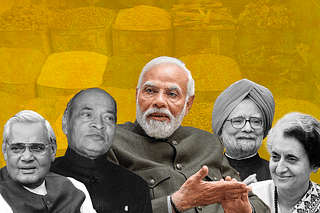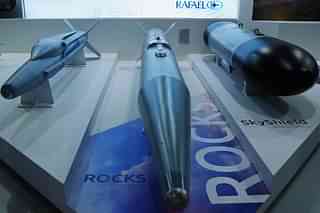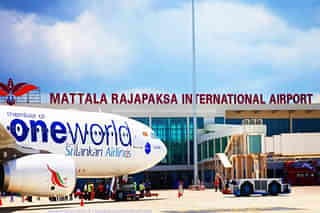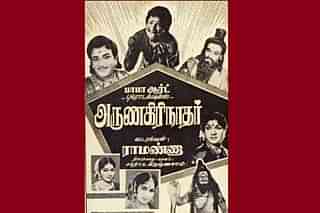Politics
Rent Seekers Of Rail Bhavan: If Modi Wants To Transform Railways, He Must Tame Its Bureaucracy First
Ajoy Chakraborty
Oct 12, 2017, 05:49 PM | Updated 05:49 PM IST
Save & read from anywhere!
Bookmark stories for easy access on any device or the Swarajya app.
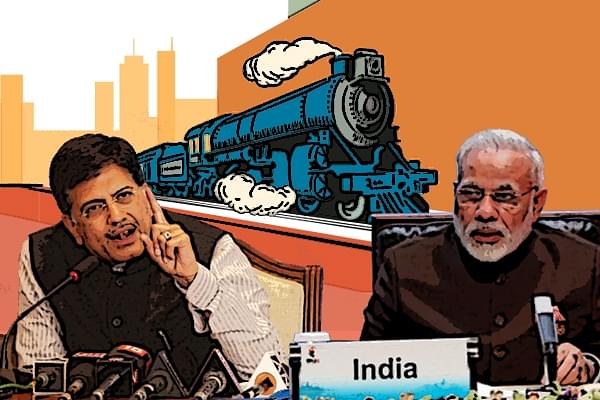
In a post dated 28 September, Indian Railways Vs GE: Why The Case For Electric Locomotives Cannot Be Ignored, this author had wondered if the railway bureaucracy had successfully gamed the railway system, putting the political executive in a tight spot.
Just a few days later, on 4 October, M R Venkatesh, gave an interview to Rediff saying:
…Modi must also realise that the people of this country are fed up of babudom. I would say babudom has successfully checkmated Narendra Modi… Modi has to demolish this Mahishasura - unless the babudom asura is slayed and buried, 2019 will be very difficult for Narendra Modi.
He is spot on. People do look up to Modi to deliver them from the bureaucracy. In this regard, the Ministry of Railways and the Ministry of Finance are proving to be the most difficult ones to tame. While rest of the ministries get covered adequately in media, it is the rail bureaucracy which has successfully resisted being lit by any media spotlight.
Untamed bureaucracy: Three ministers in three years
Despite being aware that railways is Modi’s priority, the ensnaring ways of rail bureaucracy and its entrenched systems of patronage continued unabated. To slay the demon of departmentalism, the government created a new management paradigm which eliminated battles of traction. Modi even commented on the fight between diesel and electric traction in Rail Vikas Shivir in November last year.
It was a brilliant move which was to be followed by more acts of such reorganisation, and it did calm the battle which raged like unceasing fires in coal mines.
However, following the General Electricals (GE) fracas, the ugly battle of traction reared its head again. This article, written by an unnamed railway officer and published by a rail tabloid, blamed Piyush Goyal, the Minister of Railways, and one particular department for pursuing an ‘agenda’.
This raises a disturbing question - if the battle of traction was settled, who stands to gain by rekindling this fratricidal war? Is the problem only limited to traction?
The ugly underbelly of railway procurement: Modi and Goyal should tread cautiously as they upset the Lutyens’ equivalent of Railways
The country has repeatedly been jolted by rail breakages and fractures. The Khatauli derailment exposed the rotten and imploding systems. Though this was caused by the failure of a signal joint, we were introduced to ‘rail welding’. We also have seen several near-miss accidents when rails have broken.
Not many know that SAIL’s Bhilai plant is the only supplier for rails for the Indian Railways. It is a fact that rail manufacturing is highly sensitive to process quality, but, is it also not a fact that the Bhilai plant, that makes the rails are breaking literally every day? There have been incidents in the past when certain batches of rails were more brittle and prone to breakage.
Even worse is, the Bhilai plant is equipped to meet only a small part of the rail requirement of Indian Railways, which leads to high pending replacements.
Goyal was constrained to pull up railway bureaucracy by insisting on a very simple question - why can’t there be more sources and why shouldn’t new rails be diverted first to ensure safety of revenue tracks?
Summary action taken, even at the railway board member-level, general manager and the divisional railway manager-level, meant that senior officers are now forced to exorcise the ghosts they knew always existed and confront them. ‘Adjustment’ with entrenched forces is no longer an option.
So, for the first time a startling fact has tumbled out - rail welds, something very critical to rail integrity is essentially a single source item and the so called competitors depend on the dominant player.
The entrenched incumbents exercise immense patronage, at the working level which ensures that the new entrants never get their samples proven. However, no-nonsense instructions issued by the ministry on ‘no-gift’ culture (even during festival season), would start cleaning up the haze and make manipulations difficult.
Similar vice-like control has been existing for copper conductors, where people have gamed the system by making specifications in a manner which allows very few participants to survive and sustain. The government wisely assigned the Central Bureau of Investigation (CBI) to investigate this issue well before, they decided to completely electrify the Indian railways network and prevented charges of possible corruption in the decision to electrify.
This piece on Indian Railways vs General Electrics briefly mentioned a startling fact about the dramatic drop in prices in Diesel Locomotive Works (DLW) (a factory in Modi’s constituency, saw almost halving of cost of some equipment after change of government). More than a crore was saved from each locomotive’s cost after NDA-2 came to power, saving more than Rs 300 crore a year, but this was never highlighted as an achievement by this government.
It is anybody’s guess as to why the political executive could not take credit. Suresh Prabhu was never informed. Spirited officers, freed from pressures from ‘above’, drove down the prices.
AC-AC system saw a drop from Rs 3 crore to below 2.5 crore; for traction motors, prices dropped from nearly Rs 2 crore to Rs 1.2 crore! A traction alternator saw a drop of Rs 40 lakh from Rs 1.2 crore. Difference between prices of some equipment between IR’s own factory at Chittaranjan and Varanasi should have woken up rail managers but they chose to stay silent for a decade!
It is strongly rumoured that such dramatic drop in prices would have led to very uncomfortable questions like who protected the entrenched monopolies? This gaming had lasted for almost a decade. The government’s decision to go for a CBI probe into the copper conductor case made people very apprehensive as they now faced a central government which could no longer be ‘managed’ and which was not scared of taking such manipulation head on.
Earlier, there was settled belief that ‘adjustments’ could be made up to very top, but with ministries off bound from the agents, the apple cart has been upset. Political affiliation of some of these agents might be an interesting study. Excessive imports by some departments is also an issue that needs to be addressed.
But why should the war of traction be rekindled after the government deftly settled the issue and moved to merger of departments? This strongly hints at the nexus of big vendors who are trying to ride on the back of the GE issue, who seem to be interested to make a fast buck before DLW shuts diesel locomotive production as GE wouldn’t procure such overpriced components as DLW did.
Culture of Black Box: Bleeding Railways in perpetuity as classic rent seeking case
Certain vendors successfully connived with railway bureaucracy to push and proliferate closed proprietary systems. Their claim was that open tender procurement washes all sins. By clever manipulation of the specifications and restrictive qualifying criteria, shifting goal posts, the system was gamed big time.
The philosophy of closed proprietary systems goes against the grain of wisdom gathered by aviation, marine, space, automotive sectors. This philosophy was first adopted by the Signaling Department and lapped up by Mechanical Department. Under this, core systems were termed as ‘Black Box’ and accepted as such. Thus, Signaling Systems tend to be islands and forever dependent on the OEMs for testing, commissioning, troubleshooting and repairs.
Author of this partisan and provocative piece, wondered for the fate of 5,500 diesel locomotives, questioning motives of Piyush Goyal in pushing for complete electrification of Indian Railways. He conveniently overlooks near complete dependence of India’s diesel locomotive fleet on a closed, unlisted, family-run company making profits which would make likes of GE blush. He better be advised that this fleet is more threatened by complete reliance on closed proprietary products while draining systems knowledge from the railway engineers.
It is shocking that despite investing heavily in training and creation of Centre of Excellence at electric locomotive factory at Chittaranjan, new electric locomotives are also coming with closed controls, deepening dependence on OEMs in perpetuity.
Today, two locomotives having different makes of electronics controls can not communicate with each other and get connected. So, apart from being expensive in acquisition and maintenance, these have adversely affected the railways’ ability to use the locomotives with freedom. The disease has spread to Electrical Multiple Units-where interoperability is even a more serious concern. Patrons continue to patronise, cosy in the knowledge that no one would question such technical details. Options were always available, but railways chose to continue on the path with complete disregard to interoperability.
Writing for the Times of India, one commentator provocatively questioned the decision to electrify Indian Railways by asking, what is New Delhi smoking? Can he please answer what was New Delhi smoking when it locked-in an entire fleet of locomotives into closed proprietary systems and shut down attempts to open the controls and competition?
It appears that Goyal has seen through this game. He is the first political executive to call out specification manipulation as key threat to transparency, innovation and Make in India. His threat of action for data manipulation has rattled the rail babus and the privileged rent-seekers who lived off monopolies blessed by rail bhavan mandarins. His team of young researchers and analysts are appearing formidable to the babus who sat pretty in rail bhavan.
This author had argued for bringing Ashwini Lohani back into the system (here and here)- glad that government finally listened. This no-nonsense Chairman, has struck at the feudal protocols and the practice of employing field staff at their residences. His messianic zeal to eliminate internal corruption has already being quoted widely. It will increase the morale of all levels of railwaymen who would get courage of speaking up against such whole sale manipulation of data and specifications.
One can hope that this team gets longer time to shine light on the dark corners. Dropping prices show that the Railway’s rent seekers are shaken up. Sacrificing political executive may silence public criticism, but cannot set things in order, for that, it is imperative to tame rail bhavan. As MRV argued, shut down departments, slash more than 50 per cent of rail bhavan and see how productivity and transparency multiplies while costs tumble down.
Save & read from anywhere!
Bookmark stories for easy access on any device or the Swarajya app.
Introducing ElectionsHQ + 50 Ground Reports Project
The 2024 elections might seem easy to guess, but there are some important questions that shouldn't be missed.
Do freebies still sway voters? Do people prioritise infrastructure when voting? How will Punjab vote?
The answers to these questions provide great insights into where we, as a country, are headed in the years to come.
Swarajya is starting a project with an aim to do 50 solid ground stories and a smart commentary service on WhatsApp, a one-of-a-kind. We'd love your support during this election season.
Click below to contribute.


